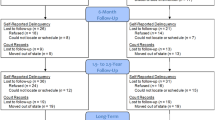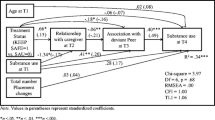Abstract
Although association with delinquent peers is a recognized precursor to ongoing delinquency problems, youth in the juvenile justice system are commonly prescribed intervention services that aggregate delinquent youth. However, little is known about the process variables that mediate the relationship between aggregating youth in intervention settings and poor subsequent outcomes. We examined data from two randomized intervention trials (one male sample and one female sample) with delinquent adolescents placed either in Multidimensional Treatment Foster Care (MTFC) or in group care. Path analyses suggested that the MTFC youth had fewer associations with delinquent peers at 12 months than did the group care youth. Further, associating with delinquent peers during the course of the intervention mediated the relationship between group condition and 12-month delinquent peer association. Implications for the development of interventions with delinquent youth are discussed.
Similar content being viewed by others
References
Achenbach, T. M. (1991). Manual for the Child Behavior Checklist/4-18 and 1991 profile. Burlington: University of Vermont, Department of Psychology.
Arbuckle, J. L., & Wothke, W. (1999). Amos 4.0 user’s guide. Chicago: SmallWaters.
Baron, R. M., & Kenny, D. A. (1986). The moderator--mediator variable distinction in social psychological research: Conceptual, strategic, and statistical considerations. Journal of Personality and Social Psychology, 51, 1173–1182.
Browne, M. W., & Cudeck, R. (1993). Alternative ways of assessing model fit. In K. A. Bollen & J. S. Long (Eds.), Testing structural equation models (pp. 136–162). Newbury Park, CA: Sage.
Capaldi, D. M., & Dishion, T. J. (1985). Describing Friends Questionnaire. Unpublished questionnaire, Oregon Social Learning Center, Eugene.
Capaldi, D. M., Dishion, T. J., Stoolmiller, M., & Yoerger, K. (2001). Aggression toward female partners by at-risk young men: The contribution of male adolescent friendships. Developmental Psychology, 37, 61–73.
Capaldi, D., & Patterson, G. R. (1989). Psychometric properties of fourteen latent constructs from the Oregon Youth Study. New York: Springer-Verlag.
Chamberlain, P. (1990). Comparative evaluation of specialized foster care for seriously delinquent youths: A first step. Community Alternatives: International Journal of Family Care, 2, 21–36.
Chamberlain, P. (2003). Treating chronic juvenile offenders: Advances made through the Oregon Multidimensional Treatment Foster Care model. Washington, DC: American Psychological Association.
Chamberlain, P., & Reid, J. B. (1987). Parent observation and report of child symptoms. Behavioral Assessment, 9, 97–109.
Chamberlain, P., & Reid, J. B. (1991). Using a specialized foster care community treatment model for children and adolescents leaving the state mental hospital. Journal of Community Psychology, 19, 266–276.
Chamberlain, P., & Reid, J. B. (1994). Differences in risk factors and adjustment for male and female delinquents in Treatment Foster Care. Journal of Child and Family Studies, 3, 23–39.
Chamberlain, P., & Reid, J. B. (1998). Comparison of two community alternatives to incarceration for chronic juvenile offenders. Journal of Consulting and Clinical Psychology, 66, 624–633.
Crick, N. R., Ostrov, J. M., Appleyard, K., Jansen, E. A., & Casas, J. F. (2004). Relational aggression in early childhood: “You can’t come to my birthday party unless,...,.” In M. Putallaz & K. L. Bierman (Eds.), Aggression, antisocial behavior, and violence among girls. New York: Guilford Press.
Dishion, T. J. (2000). Cross-setting consistency in early adolescent psychopathology: Deviant friendships and problem behavior sequelae. Journal of Personality, 68, 1109–26.
Dishion, T. J., Andrews, D. W., & Crosby, L. (1995). Antisocial boys and their friends in adolescence: Relationship characteristics, quality, and interactional processes. Child Development, 66, 139–151.
Dishion, T. J., Capaldi, D., Spracklen, K. M., & Li, F. (1995). Peer ecology of male adolescent drug use. Development and Psychopathology, 7, 803–824.
Dishion, T. J., Eddy, J. M., Haas, E., Li, F., & Spracklen, K. M. (1997). Friendships and violent behavior during adolescence. Social Development, 6, 207–225.
Dishion, T. J., & Loeber, R. (1985). Male adolescent marijuana and alcohol use: The role of parents and peers revisited. American Journal of Drug and Alcohol Abuse, 11, 11–25.
Dishion, T. J., McCord, J., & Poulin, F. (1999). When interventions harm: Peer groups and problem behavior. American Psychologist, 54, 755–764.
Dishion, T. J., & Medici Skaggs, N. (2000). An ecological analysis of monthly “bursts” in early adolescent substance use. Applied Developmental Science, 4, 89–97.
Eddy, J. M., & Chamberlain, P. (2000). Family management and deviant peer association as mediators of the impact of treatment condition on youth antisocial behavior. Journal of Consulting and Clinical Psychology, 68, 857–863.
Eddy, J. M., Whaley, R. B., & Chamberlain, P. (2004). The prevention of violent behavior by chronic and serious male juvenile offenders: A 2-year follow-up of a randomized clinical trial. Journal of Emotional and Behavioral Disorders, 12, 2–8.
Elliott, D. S. (Ed.). (1998). Blueprints for violence prevention. Boulder: Institute of Behavioral Science, Regents of the University of Colorado.
Elliott, D. S., Huizinga, D., & Ageton, S. S. (1985). Explaining delinquency and drug use. Beverly Hills, CA: Sage.
Elliott, D. S., & Menard, S. (1996). Delinquent friends and delinquent behavior: Temporal and developmental patterns. In J. D. Hawkins (Ed.), Delinquency and crime: Current theories (pp. 28–67). New York: Cambridge University Press.
Hawkins, J. D., Catalano, R. F., & Miller, J. Y. (1992). Risk and protective factors for alcohol and other drug problems in adolescence and early adulthood: Implications for substance abuse prevention. Psychological Bulletin, 112, 64–105.
Hops, H., Davis, B., & Lewin, L. M. (1999). The development of alcohol and other substance use: A gender study of family and peer context. Journal of Studies on Alcohol, 13, 22–31.
Judd, C. M., & Kenny, D. A. (1981). Process analysis: Estimating mediation in treatment evaluations. Evaluation Review, 5, 602–619.
Leve, L. D., & Chamberlain, P. (2004). Female juvenile offenders: Defining an early-onset pathway for delinquency. Journal of Child and Family Studies, 13, 439–452.
Leve, L. D., & Chamberlain, P. (2005). Intervention outcomes for girls referred from juvenile justice: Effects on delinquency. Manuscript submitted for publication.
Oetting, G. R., & Beauvais, F. (1990). Adolescent drug use: Findings of national and local surveys. Journal of Consulting and Clinical Psychology, 58, 385–394.
Patterson, G. R., Dishion, T. J., & Yoerger, K. (2000). Adolescent growth in new forms of problem behavior: Macro- and micro-peer dynamics. Prevention Science, 1, 3–13.
Patterson, G. R., Forgatch, M. S., Yoerger, K., & Stoolmiller, M. (1998). Variables that initiate and maintain an early-onset trajectory for juvenile offending. Development and Psychopathology, 10, 531–547.
Pawlby, S. J., Mills, A., & Quinton, D. (1997). Vulnerable adolescent girls: Opposite-sex relationships. Journal of Child Psychology and Psychiatry, 38, 909–920.
Rutter, M., Quinton, D., & Hill, J. (1990). Adult outcome of institution-reared children: Males and females compared. In L. Robins & M. Rutter (Eds.), Straight and devious pathways from childhood to adulthood (pp. 135–157). New York: Cambridge University Press.
Schafer, J. L., & Graham, J. W. (2002). Missing data: Our view of the state of the art. Psychological Methods, 7, 147–177.
Underwood, M. K. (2003). Social aggression among girls. New York: Guilford Press.
U.S. Department of Commerce (1992). 1990 census of population: General population characteristics, Oregon (USDC Publication No. 1990 CP-1-39). Washington, DC: U.S. Government Printing Office.
U.S. Department of Health and Human Services. (1999). Mental health: A report of the Surgeon General (DHHS publication No. DSL 2000-0134-P). Washington, DC: U.S. Government Printing Office.
Wothke, W. (2000). Longitudinal and multigroup modeling with missing data. In T. D. Little & K. U. Schnabel (Eds.), Modeling longitudinal and multilevel data: Practical issues, applied approaches, and specific examples (pp. 219–240, 269–281). Mahwah, NJ: Erlbaum.
Author information
Authors and Affiliations
Corresponding author
Rights and permissions
About this article
Cite this article
Leve, L.D., Chamberlain, P. Association with Delinquent Peers: Intervention Effects for Youth in the Juvenile Justice System. J Abnorm Child Psychol 33, 339–347 (2005). https://doi.org/10.1007/s10802-005-3571-7
Received:
Revised:
Accepted:
Issue Date:
DOI: https://doi.org/10.1007/s10802-005-3571-7




